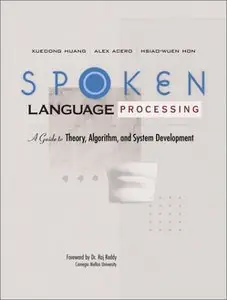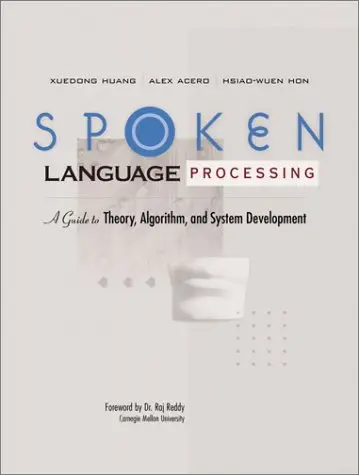Spoken Language Processing: A Guide to Theory, Algorithm and System Development
Prentice Hall PTR | 2001-05-05 | ISBN: 9780130226167 | 1008 Pages | PDF | 14,4 MB
Prentice Hall PTR | 2001-05-05 | ISBN: 9780130226167 | 1008 Pages | PDF | 14,4 MB
Offers coverage of new advances in spoken language processing in computer science, drawing on the most recent discoveries in computer science, electrical engineering, mathematics, and other fields. Covers speech recognition, speech processing, spoken language understanding, speech synthesis, and speech interface design. DLC: Natural language processing (Computer science).
Summary: A classic and comprehensive resource
Rating: 5
This book is a comprehensive overview of most of the major topics associated with speech processing. Divided into five main sections, the book is well structured with a clear division of concerns. The title, "Spoken Language Processing", may be misleading to some as language processing topics only accounts for one section of the book.
The first two sections cover the fundamental theories that should be understood before embarking in-depth into a study of speech processing. This may seem an obvious approach but many texts do not follow this pattern making their use as reference tomes limited. Separating background theory from its use is also useful in that it allows a rigorous approach to its description. Too often texts give a hurried imprecise overview of theories used before launching into a long and complex use of the theory; losing the reader instantly in a quagmire of formulae.
The first two sections of the book deals with background material, material that the reader should at least understand the key concepts of. The first section concentrates on speech in general (including production and perception), probability and statistics, and pattern classification. These last two topics mentioned are both important parts of the book and are dealt with in their own chapters. Both are well written with the right amount of explanation and background. Much of the remainder of the book expects at least some familiarity with the material presented here. These chapters, like all chapters in the book finish with a section entitled, "Historical Perspective and Further Reading". The inclusion of recommended further reading, in addition to the vast number of references appearing in each chapter, make the book as a whole a very good starting point for any work in speech processing.
The second section concerns itself with the DSP topics which relate to speech processing. In this section the reader will find everything from FFTs to multi-rate signal processing and speech signal representations to speech coding. Again the section is well written and the reader is not forced to refer to other texts to understand what is written. If a topic is not expanded upon here then it is an indication that is not dealt further in any great depth in the remainder of the book.
The third section of the book covers speech recognition and is probably the section which will find most use with many readers. This section is very thorough in its treatment of the subject. It starts immediately with a discussion of Hidden Markov Models which is almost exclusively the method employed in the pattern matching stage of speech recognition. Any algorithms that are mentioned are also detailed which really make the book useful. In fact algorithms are presented throughout the book making it a practical reference as much as a theoretical one. This is important because there is a big jump from understanding theory to being able to implement an algorithm to exploit that theory. Other topics covered include an excellent chapter on environmental robustness with one of the best discussions of microphones I have seen. Language modelling and search algorithms are given a thorough treatment. I would like to have seen more detailed information on front-end processing and endpoint detection, as this remains a critical stage of the recognition process. Perhaps the level of detail reflects the fact that this is currently a hot research topic with potential for significant advancement.
Section four, on text-to-speech processing, is a good overview of the field and better than any book I've seen on the subject. It shows numerous block diagrams of what you need to build such a system and gives numerous algorithms in pseudocode. It also dedicates a subsection to each block of the text-to-speech system block diagram, discussing in detail what you would need to do to implement that particular block. Since much of the individual blocks have been discussed earlier in the book, it refers you back to specific earlier sections for details.
The fifth section is a short one on entire systems and shows some case studies, concentrating on what Microsoft was doing at the time this book was published, since that is where the authors' research came from. I would highly recommend that anyone anticipating getting into speech processing have a copy of this classic nearby.
Download Link bellow:
Link
Link



